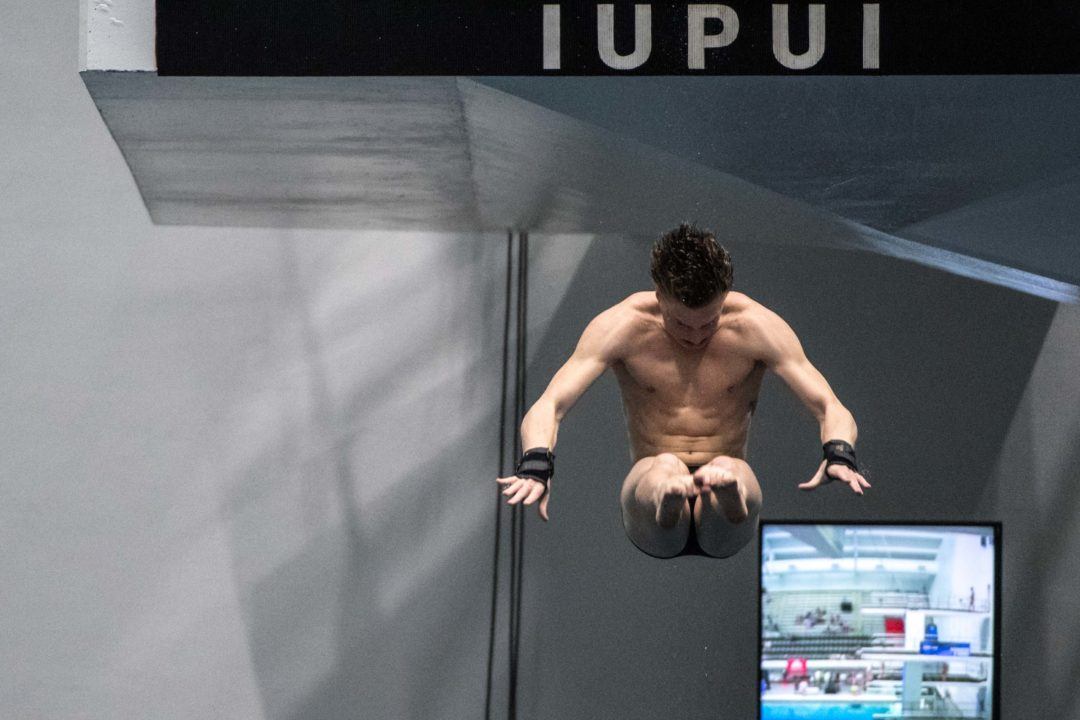The ever-complicated NCAA diving qualification process begins this week with Zone Diving Championships, and it’s time to take a look at how divers qualify for the collegiate national championships.
At the Division I level, divers qualify through their zone finishes, with each zone earning different amounts of NCAA qualifiers based on past seasons’ performances at NCAAs.
NCAA ZONE QUALIFYING PROCEDURES
There are five zone meets spread across the country that allow divers to qualify for the NCAA Championships. Based on performances at the previous NCAAs each zone earns a set number of qualifying spots.
Take a look at the qualifying spots for each zone and each event:
WOMEN
| Women | Eligibility | ||
| 1m | 3m | Platform | |
| Zone A | 6 | 6 | 5 |
| Zone B | 7 | 7 | 9 |
| Zone C | 8 | 10 | 10 |
| Zone D | 11 | 9 | 9 |
| Zone E | 9 | 9 | 8 |
Men
| Men | Eligibility | ||
| 1m | 3m | Platform | |
| Zone A | 6 | 5 | 5 |
| Zone B | 6 | 6 | 7 |
| Zone C | 10 | 10 | 11 |
| Zone D | 9 | 8 | 6 |
| Zone E | 5 | 7 | 7 |
A priority chart determines who gets the reimbursement spots. The first priority spot is taken by the winner of each event beginning with the 3-meter champ, followed by the 1-meter champ and then the platform champ. If an athlete wins two events, they will still only take up one slot which means the NCAA will keep adding rows to this chart until the zone meet reimbursement quota is met.
According to the rules set in 2015 that allowed more divers into the meet, any diver who lands in the qualifying spots for their zone earns a spot to compete in the NCAA Championships. If the diver earns eligibility in one event, they can automatically compete in any of the other two events at NCAAs as long as they finished in the top 12 in their zone in that event.
The NCAA made a distinction between “eligible” and “reimbursed” athletes. Divers qualifying outside of the reimbursement spots will not have their travel, lodging, or meet expenses covered by the NCAA. Instead the individual school must decide if they’re willing to pay the bill themselves to give that diver an opportunity to participate in the NCAA Championships.
| Reimbursement | ||
| Women | Men | |
| Zone A | 4 | 4 |
| Zone B | 6 | 7 |
| Zone C | 10 | 10 |
| Zone D | 12 | 9 |
| Zone E | 9 | 5 |
Here’s how the first 20 priority spots are taken. The list continues on in the same order through 48 spots.
| PRIORITY | FINISHER |
| 1 | 3-meter Champ |
| 2 | 1-meter Champ |
| 3 | Platform Champ |
| 4 | 3-meter 2nd |
| 5 | 1-meter 2nd |
| 6 | Platform 2nd |
| 7 | 3-meter 3rd |
| 8 | 1-meter 3rd |
| 9 | Platform 3rd |
| 10 | 3-meter 4th |
| 11 | 1-meter 4th |
| 12 | Platform 4th |
| 13 | 3-meter 5th |
| 14 | 1-meter 5th |
| 15 | Platform 5th |
| 16 | 3-meter 6th |
| 17 | 1-meter 6th |
| 18 | Platform 6th |
| 19 | 3-meter 7th |
| 20 | 3-meter 7th |
The Pre-Championships Manual that shows all of the NCAA qualifying procedures can be found here.
ZONE CHAMPIONSHIP MEETS
Here’s a breakdown of each zone, dates of competition, the host of each zone, and where you can find results.
- Zone A – March 5-7, Rutgers University (Results)
- Zone B – March 5-7, University of Tennessee (Results)
- Zone C – March 8-10, Ohio State University (Results)
- Zone D – March 5-7, University of Minnesota (Results)
- Zone E – March 5-7, Northern Arizona University (Results)
As competition begins for these divers starting on March 5 and wrapping up March 10, we will be paying close attention to how the results from Zones will impact the team scores at the NCAA Championships later this month.
